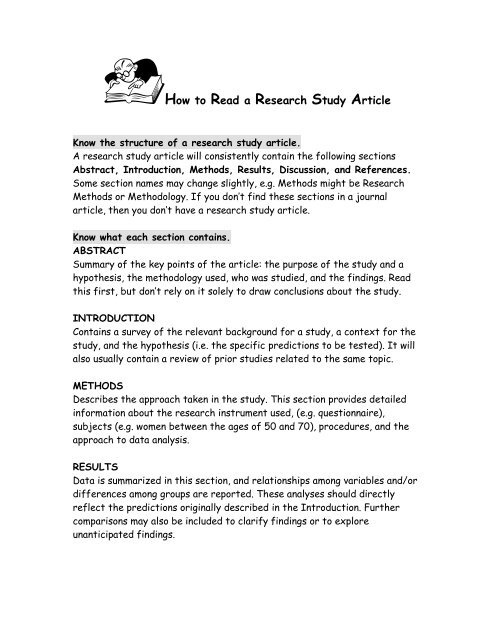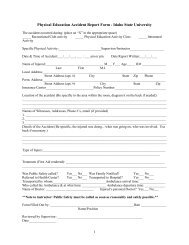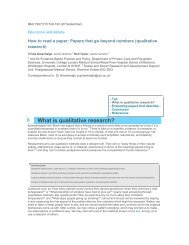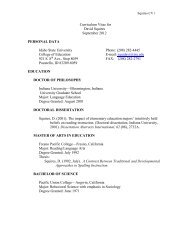How to Read a Research Study Article
How to Read a Research Study Article
How to Read a Research Study Article
Create successful ePaper yourself
Turn your PDF publications into a flip-book with our unique Google optimized e-Paper software.
<strong>How</strong> <strong>to</strong> <strong>Read</strong> a <strong>Research</strong> <strong>Study</strong> <strong>Article</strong><br />
Know the structure of a research study article.<br />
A research study article will consistently contain the following sections<br />
Abstract, Introduction, Methods, Results, Discussion, and References.<br />
Some section names may change slightly, e.g. Methods might be <strong>Research</strong><br />
Methods or Methodology. If you don’t find these sections in a journal<br />
article, then you don’t have a research study article.<br />
Know what each section contains.<br />
ABSTRACT<br />
Summary of the key points of the article: the purpose of the study and a<br />
hypothesis, the methodology used, who was studied, and the findings. <strong>Read</strong><br />
this first, but don’t rely on it solely <strong>to</strong> draw conclusions about the study.<br />
INTRODUCTION<br />
Contains a survey of the relevant background for a study, a context for the<br />
study, and the hypothesis (i.e. the specific predictions <strong>to</strong> be tested). It will<br />
also usually contain a review of prior studies related <strong>to</strong> the same <strong>to</strong>pic.<br />
METHODS<br />
Describes the approach taken in the study. This section provides detailed<br />
information about the research instrument used, (e.g. questionnaire),<br />
subjects (e.g. women between the ages of 50 and 70), procedures, and the<br />
approach <strong>to</strong> data analysis.<br />
RESULTS<br />
Data is summarized in this section, and relationships among variables and/or<br />
differences among groups are reported. These analyses should directly<br />
reflect the predictions originally described in the Introduction. Further<br />
comparisons may also be included <strong>to</strong> clarify findings or <strong>to</strong> explore<br />
unanticipated findings.
DISCUSSION<br />
Results are summarized in narrative form as opposed <strong>to</strong> statistics or<br />
numbers. The ways in which the study’s results coincide with the hypothesis<br />
and previous studies will also be discussed, as well as suggestions for the<br />
need for further studies on the <strong>to</strong>pic.<br />
REFERENCES<br />
Listing of the sources cited in the article such as books and articles, as well<br />
as sources not directly used but are relevant <strong>to</strong> the <strong>to</strong>pic. NOTE: Use the<br />
Reference list <strong>to</strong> find still other sources on your <strong>to</strong>pic!<br />
Now you’re ready <strong>to</strong> read.<br />
Not first <strong>to</strong> last page, unless you’re really familiar with the <strong>to</strong>pic. Instead,<br />
1. Start with the Abstract for an overview.<br />
2. <strong>Read</strong> the first paragraph or so of the Introduction <strong>to</strong> get a sense of<br />
the issue. Go <strong>to</strong> the last paragraph <strong>to</strong> read the hypothesis.<br />
3. Skim the Discussion <strong>to</strong> see how the study turned out.<br />
4. Now, go back <strong>to</strong> the middle part for the details. <strong>Read</strong> the Methods<br />
section carefully and plan <strong>to</strong> reread it, even a couple of times <strong>to</strong><br />
digest it all.<br />
5. Then, read the Results section. You may want <strong>to</strong> turn <strong>to</strong> the<br />
Discussion section for clarification of what the reported statistics<br />
demonstrate. Don’t get bogged down in the details of either the<br />
Methods or the Results section, but try <strong>to</strong> get a good idea of how the<br />
hypotheses were tested.<br />
6. <strong>Read</strong> the Discussion section more closely.<br />
7. Finally, read the whole article, first page <strong>to</strong> last page. Reread for the<br />
greatest comprehension.<br />
Adapted from: Franzoi, S.L. & Ratlif-Crain, J. (2003). Guide <strong>to</strong> reading research articles. In<br />
Instruc<strong>to</strong>r's manual <strong>to</strong> accompany social psychology. 3rd ed. (pp.29-30). Bos<strong>to</strong>n:McGraw-<br />
Hill.<br />
DF 10/02






